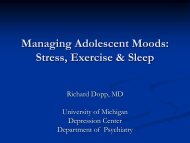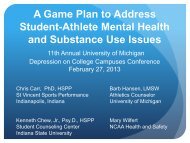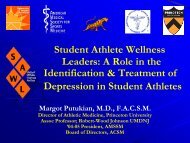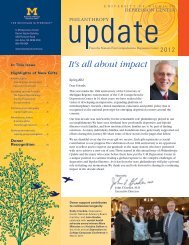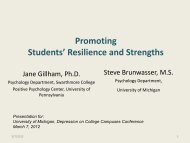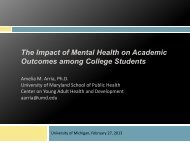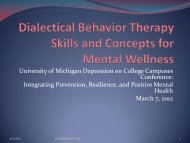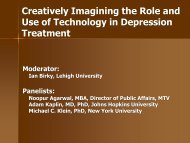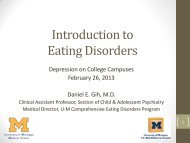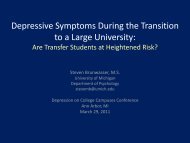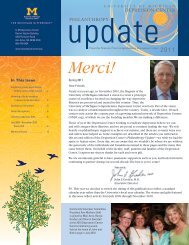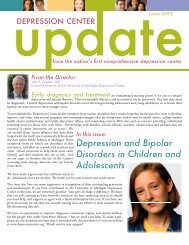Richard Dopp - University of Michigan Depression Center
Richard Dopp - University of Michigan Depression Center
Richard Dopp - University of Michigan Depression Center
Create successful ePaper yourself
Turn your PDF publications into a flip-book with our unique Google optimized e-Paper software.
Physical Activity,<br />
Sleep, and <strong>Depression</strong><br />
<strong>Richard</strong> <strong>Dopp</strong>, MD<br />
<strong>University</strong> <strong>of</strong> <strong>Michigan</strong><br />
Child and Adolescent Psychiatry
Disclosures<br />
• None<br />
• Research funding:<br />
Klingenstein Third Generation Foundation<br />
<strong>Michigan</strong> Institute <strong>of</strong> Clinical Health Research<br />
Rachel Upjohn Clinical Scholars Award<br />
<strong>Center</strong> for Research on Learning and Teaching<br />
Gilmore Fund for Sleep Research and Education<br />
Office <strong>of</strong> the Vice President for Research (Univ. <strong>of</strong> <strong>Michigan</strong>)
“Eat right, sleep right, and get<br />
your exercise!”
Physical Educators
Physical Education Classes
Physical Activity in Adolescence
<strong>Depression</strong> in Adolescence<br />
• Prevalence up to 8.3% in<br />
early adolescence.<br />
• By age 18, one in four<br />
adolescents will experience<br />
at least one depressive<br />
episode.<br />
• Females outnumber males<br />
2 to 1 by late adolescence<br />
(Wichstrom, 1999; Kessler<br />
et al., 1996).
Evidence-Based Treatments<br />
• Cognitive Behavioral<br />
• Interpersonal<br />
• Dialectical Behavioral<br />
• Medications
Physical Activity and <strong>Depression</strong><br />
in Adolescence<br />
• Actigraphy studies in<br />
children and adolescents<br />
with depression show they<br />
are less active than their<br />
healthy peers.<br />
Roseanne Armitage PhD., Robert H<strong>of</strong>fmann PhD, Graham<br />
Emslie MD, Jeanne Rintelman BS, Jarrette Moore MA. Kelly<br />
Lewis BS (JAACAP 2004)
Neurobiological Theory<br />
• Increase in opiate<br />
receptor occupancy in rat<br />
brain (Pert et al., 1979).<br />
• Increase in steady-state<br />
levels <strong>of</strong> brain NE in<br />
physically active rats<br />
(Brown, 1973).<br />
• Increase in BDNF in rats<br />
following physical<br />
activity (Oliff et al.,<br />
1998).
Wheel Running
Blumenthal et al., 1999<br />
Exercise and SSRIs
Exercise treatment for depression:<br />
efficacy and dose response<br />
Dunn, Trivedi et al., 2005
READY<br />
• Research on Exercise And <strong>Depression</strong> in Youth<br />
• Pilot, feasibility study.<br />
• Can you get a teenager with depression to<br />
participate in an exercise intervention?
READY<br />
Study Protocol<br />
This protocol required participants to:<br />
• spend 4 nights in the Sleep and Chronophysiology Lab,<br />
• complete 12 weeks <strong>of</strong> intervention including exercise 3<br />
times each week,<br />
• wear an actigraph watch 24/7 for several weeks,<br />
• participate in 2 clinical interviews, and<br />
• fill out surveys and self-report questionnaires.
READY<br />
Participants<br />
13 Adolescents<br />
Ages 13 – 17 years, M = 15.2, SD = 1.4<br />
Females = 9 Males = 4<br />
Racial/Ethnic Background:<br />
Caucasian = 7 (54%) African American = 3 (23%)<br />
Hispanic = 1 (8%) Bi-racial/Multi-ethnic = 2 (15%)
READY<br />
Participants<br />
• Medical Diagnoses:<br />
Major Depressive Disorder = 11 (85%)<br />
Depressive Disorder NOS = 2 (15%)<br />
• Co-morbid diagnoses:<br />
1 with ADHD<br />
1 with Anxiety Disorder NOS<br />
2 with both ADHD and Anxiety Disorder NOS
READY<br />
Medications<br />
• 7 participants were taking no meds.<br />
• 5 participants were taking SSRIs<br />
throughout the intervention:<br />
fluoxetine (4), and sertraline (1).<br />
• 3 <strong>of</strong> these 5 were also on<br />
stimulants.<br />
• 1 participant initiated sertraline in<br />
the 2 nd week <strong>of</strong> the intervention.
READY<br />
Motivation:<br />
Reasons for Participation<br />
• for the structured exercise (5),<br />
• to lose weight (5),<br />
• for incentive money (5),<br />
• to fight their depression (4),<br />
• to be involved in research (2),<br />
• to help other people (1).
READY<br />
Adverse Events<br />
Adverse events experienced by the adolescent<br />
participants during the intervention phase:<br />
parental separation (2)<br />
temporary homelessness (1)<br />
suicide attempt (1)<br />
orthopedic injury (2)<br />
arrest by police (1)
READY<br />
Feasibility<br />
100% <strong>of</strong> participants who initiated the physical<br />
activity intervention completed the study.<br />
<strong>Dopp</strong>, Mooney, Armitage, King (Manuscript submitted)
READY<br />
• Total 15.<br />
Supervised Sessions<br />
• Took on average 14.25 weeks to complete.<br />
• Heart rate measured every 10 minutes.<br />
• Average heart rate ranged from 124 to 181.
READY<br />
Independent Sessions<br />
• Actigraphy watches:<br />
• worn 24/7 at weeks 3 and 11.<br />
• Used to verify self-reported independent<br />
physical exercise sessions.<br />
• 81% <strong>of</strong> reported exercise was verified via<br />
actigraphy.
PAQ-A Scores<br />
READY<br />
PAQ-A<br />
3.5<br />
Physical Activity<br />
3<br />
2.5<br />
2<br />
1.5<br />
1<br />
Baseline Post-intervention 6 Months<br />
Timeline
C D R S -R Scores<br />
READY<br />
CDRS-R<br />
80<br />
<strong>Depression</strong> Severity<br />
70<br />
60<br />
50<br />
40<br />
30<br />
20<br />
10<br />
Baseline Post-intervention 6 Months<br />
Timeline
Mean CASAFS Scores<br />
READY<br />
CASAFS<br />
Adaptive Functioning<br />
70<br />
69<br />
68<br />
67<br />
66<br />
65<br />
64<br />
63<br />
62<br />
Baseline Post-intervention 6 Months
READY<br />
Adaptive Functioning<br />
CASAFS<br />
• In females, peer relationships showed significant<br />
improvement [t (12)=-2.67, p
READY<br />
Correlations<br />
• Average heart rate was not correlated with<br />
change in depression severity between baseline<br />
and post-intervention.<br />
• Average heart rate was correlated with a greater<br />
reduction in BMI (r=0.75, p
READY<br />
Participants<br />
• <strong>Center</strong>s for Disease Control<br />
BMI Weight Category:<br />
Healthy = 3 (23%)<br />
Overweight = 5 (38.5%)<br />
Obese = 5 (38.5%)
Prevalence Rates <strong>of</strong> BMIs Greater Than the 95th<br />
Percentile and 85th Percentile<br />
National Longitudinal Survey <strong>of</strong> Youth<br />
1986-1998<br />
Strauss, R. S. et al. JAMA 2001;286:2845-2848.<br />
Strauss, R. S. et al. JAMA 2001;286:2845-2848.<br />
Copyright restrictions may apply.
Obesity and <strong>Depression</strong><br />
• <strong>Depression</strong> and conduct problems in childhood<br />
predict later development <strong>of</strong> obesity (Duarte et<br />
al., 2009)<br />
• Chronic obesity in childhood increases risk for<br />
depression (Mustillo et al., 2003)
Obesity and Sleep in Children<br />
• Shorter sleep duration in 3rd grade was<br />
associated with overweight in 6th grade,<br />
independent <strong>of</strong> the child's weight status in 3rd<br />
grade.<br />
• Shorter sleep duration in 6th grade was<br />
associated with overweight in 6th grade.<br />
• <strong>Depression</strong> was associated with overweight in<br />
6th grade.<br />
Lumeng et al., 2007; PEDIATRICS
Sleep and BMI in <strong>Depression</strong><br />
Higher BMI associated with decreased sleep efficiency.
Sleep and <strong>Depression</strong><br />
TADS<br />
Kennard et al., 2006
Physical Activity and Sleep<br />
Among healthy adults:<br />
• Increase in total sleep time.<br />
• Increase in amount <strong>of</strong> slow-wave sleep.<br />
• Prolonged REM latency.<br />
• Moderators <strong>of</strong> this effect include body<br />
temperature, exercise duration, and exercise<br />
timing.<br />
Youngstedt et al., 1997
READY<br />
Randomized Controlled Trial<br />
• Goal: Recruit adolescents with depressive<br />
disorders who are inactive, and have a sleep<br />
complaint.<br />
• Participants are randomly assigned to 12 weeks<br />
<strong>of</strong> exercise or treatment-as-usual (TAU).
READY<br />
Demographics<br />
12 Adolescents<br />
Ages 13 – 19 years, M = 15.3, SD = 1.8<br />
Females = 9 Males = 4<br />
Racial/Ethnic Background:<br />
Caucasian = 7 (54%) African American = 3 (23%)<br />
Hispanic = 1 (8%) Bi-racial/Multi-ethnic = 2 (15%)
READY<br />
Exercise or TAU<br />
• Exercise condition (n=6)<br />
3 dropped out (week 2, 5, and 10)<br />
• Treatment-As-Usual (n=6)
Change in <strong>Depression</strong><br />
Treatment-As-Usual vs. Exercise<br />
t (20)= -2.59; p
<strong>Depression</strong> Among <strong>University</strong><br />
Students<br />
• The prevalence <strong>of</strong> positive screens for<br />
depression was 13.8% for undergraduates and<br />
11.3% for graduate students.<br />
• Suicidal thoughts in the last 4 weeks were<br />
reported by 2.3% <strong>of</strong> undergraduates and 1.6% <strong>of</strong><br />
graduate students.<br />
Eisenberg et al., 2007
Women’s College Physical<br />
Activity and Future <strong>Depression</strong><br />
• Women who are physically active during college<br />
have significantly less physician-diagnosed<br />
depression in their middle and older ages.<br />
Wyshak, 2001
Physical Activity Benefits<br />
• Academic performance<br />
• Productivity and salary increases<br />
• Decreases in cardiovascular disease<br />
• Decreases in diabetes mellitus<br />
• Mortality rates are significantly lower among<br />
college graduates who are physically active<br />
(Paffenbarger et al., 1986).
Obesity Increase<br />
•The time <strong>of</strong> greatest increase <strong>of</strong><br />
overweight and obesity occurs<br />
between the ages <strong>of</strong> 18 and 29.<br />
Gordon-Larsen et al., 2004; Mokdad et al., 1999
College Students’ Barriers to<br />
Healthful Weight Management<br />
• Intrapersonal (temptation, lack <strong>of</strong> discipline)<br />
• Interpersonal (social situation)<br />
• Environmental (time constraints, ready access to<br />
unhealthful food)<br />
Greaney et al., 2009
College Students’ Enablers for<br />
Healthful Weight Management<br />
• Intrapersonal (regulating food intake, being<br />
physically active)<br />
• Interpersonal (social support)<br />
• Environmental (university’s environment as<br />
supportive <strong>of</strong> physical activity)<br />
Greaney et al., 2009
College Student Physical Activity<br />
• What do you see as barriers to<br />
engagement in physical activity in<br />
college students?<br />
• What can be done to reduce those<br />
barriers and encourage more physical<br />
activity?
Take Home Points<br />
• Aerobic exercise is proven to<br />
have a significant impact on<br />
adults with depression.<br />
• Research investigating this<br />
relationship in adolescents is<br />
encouraging.<br />
• Individually focused and<br />
environmental-level<br />
interventions are needed to<br />
facilitate behavior change.
Mental Health Resources<br />
• Campus Mind Works:<br />
www.campusmindworks.org/downloads/<br />
• Provides information about managing your<br />
mental health while in college. Find a free<br />
exercise log to track your physical activity and<br />
mood, along with helpful tips.
Exercise Resources<br />
• Department <strong>of</strong> Recreational Sports:<br />
http://www.recsports.umich.edu/<br />
• FREE access to the Department <strong>of</strong> Recreational Sports facilities<br />
– Central Campus Recreation Building (CCRB), North Campus<br />
Recreation Building (NCRB), and Intramural Sports Building<br />
(IMSB) – is granted to students who are enrolled in classes for<br />
the current term or semester and have paid tuition and student<br />
fees.<br />
• Department Hotline: (734) 763-0050<br />
• Rec sports also has information intramural and club sports,<br />
outdoor adventures, and challenge programs.<br />
• Campus Running Maps:<br />
http://www.recsports.umich.edu/facilities/RunnersMap.pdf
Exercise Resources<br />
• MHealthy Exercise and Relaxation Classes: (734) 647-7888<br />
• http://hr.umich.edu/mhealthy/programs/activity/classes/index<br />
.html<br />
• http://hr.umich.edu/mhealthy/programs/activity/personaltraini<br />
ng.html<br />
• U-Move Fitness:<br />
http://hr.umich.edu/mhealthy/programs/activity/classes/index<br />
.html<br />
• U-Move Fitness <strong>of</strong>fers a wide variety <strong>of</strong> group exercise and<br />
wellness classes on campus. Phone: (734) 764-1342
Exercise Resources<br />
• Ann Arbor Community Education and Recreation (Rec&Ed):<br />
http://www.aareced.com/reced.home/rec___ed_home<br />
• Offers league and team sports for youth and adults.<br />
• Phone: (734) 994-2300, ext. 0<br />
• Ann Arbor Parks and Recreation:<br />
http://www.a2gov.org/government/communityservices/parksa<br />
ndrecreation/Pages/default.aspx<br />
• Provides information about recreation activities in the area,<br />
including parks, golf courses, and pools.<br />
• Phone: (734) 794-6230
• Participants and families<br />
• Roseanne Armitage, PhD<br />
• Cheryl King, PhD<br />
• Sheila Marcus, MD<br />
• John Greden, MD<br />
• Ann Mooney, MSW<br />
• Karan Patel, ME<br />
• Zach Ciullo<br />
• Samarth Bhandari<br />
• Jenish Patel<br />
• Keri James<br />
• Barbara Berman, PhD<br />
• Deborah Berman, MD<br />
Acknowledgements
Questions
Running group in young females<br />
with depression<br />
A = 21<br />
B = 28<br />
Nabkasorn et al., 2005; European Journal <strong>of</strong> Public Health
Treatment Options



